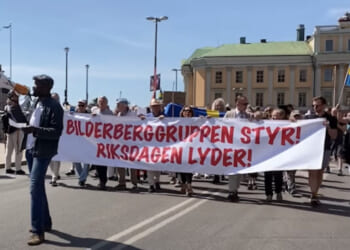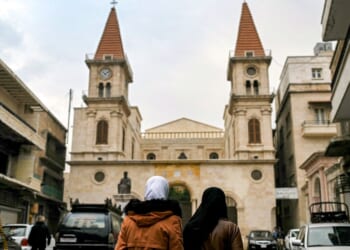What follows is an interview conducted by AFP’s James Edwards with Cyan Quinn, director of the White Papers Policy Institute, an organization dedicated to publicizing information about and reversing what has become known as the Great Replacement of white people not only in North America, but Europe and the greater white world, as well.
American Free Press: Please inform our readers about the mission of the White Papers Policy Institute.
Cyan Quinn: There are already so many excellent outlets that encourage whites to take our own side when faced with the inevitable conflicts that come with multiculturalism. At White Papers, we channel that energy into productive policymaking that will reverse the great replacement in a humane and practical way.
Click the Link Below to Listen to the Audio of this Article
AFP: A recent event known as the Remigration Summit was held a few days ago in Milan, Italy. What was the purpose of this conference?
Quinn: Remigration should be the top priority of any pro-White policy platform, so we were delighted to participate. Austrian identitarian activist Martin Sellner earned significant media attention last year when he presented at a secret meeting in Potsdam, which included Ronald Hartwig, Alternative for Germany (AfD) Party co-chairman Alice Weidel’s then-senior aide. The topic of his talk was remigration—the deliberate reverse-migration of recent unassimilated immigrants back to their home countries. This will restore the appropriate demographic dominance of the core ethnic group of the nation.
Left-wing media blasted the AfD for Hartwig’s attendance, Weidel fired him and shifted the party’s focus to Dexit, Germany’s version of Brexit. One year later, however, the AfD has a spokesperson for remigration, Lena Kotre, and is the top-polling party in Germany.
Clearly, remigration is a winning issue, so Sellner and other activists, such as: Andrea Ballerati from Italy; Afonso Goncalez, leader of the Reconquista Party in Portugal; and former Member of Parliament Dries van Langenhove organized a summit with at least seven European political parties represented with the purpose of coming up with a plan.
AFP: This event came under heavy fire from the media and even some governments in Europe. What tactics were employed in hopes of disrupting this gathering?
Quinn: The mayor of Milan attempted to ban the conference, but the suppression backfired thanks to the energy of our audience on social media. The conflict earned international attention and, at a Lega Party event near Milan the day before the summit, Deputy Prime Minister and Minister of Infrastructure Matteo Salvini told Italian news outlets:
I don’t understand why someone’s free thought should be banned a priori. We are not in the Soviet Union. … If someone fears that mass immigration is a huge and devastating problem, and I am among them, they must be able to express it.
On the day of the event itself, there was ample police protection and no Antifa in sight of the venue. There was a counter-protest, but it was in Milan city center about an hour by car from the venue itself. While it’s always fun to see the zoo animals, it was better to have a peaceful, productive event.
AFP: The event organizers remarkably overcame this adversity, to the raucous applause of the sold-out crowd. What was the energy like inside the venue?
Quinn: Everyone was overjoyed to be there. Many couldn’t believe we were actually having the event, as if we were all waiting to blink and wake up from a dream. This was the third venue the organizers had to arrange—all at the last minute. And, even then, this venue rescheduled the event from the afternoon to the morning. An event that was supposed to begin at 2 p.m. now began at 9 a.m.
Despite these logistical disruptions, the Italian identitarian volunteers running the audio-visual managed to arrange everything so that the event had the visual effect of something like CPAC [Conservative Political Action Conference], but with the youthful energy of a pop-up dance event.
AFP: You not only attended the summit, you were also a featured speaker. What was your topic?
Quinn: At White Papers, we have two fully developed remigration policy proposals—one for the United States, and one for the United Kingdom. Because each demographic is unique, we also break down U.S. repatriation into three categories: Hispanics, blacks, and Asians. We’re the first publication to propose a practical plan, and one that’s economically viable. Many of the speakers gave rousing moral arguments for remigration, but we presume the moral argument and take a data-
driven practical approach to make it a reality. So I was delighted to be asked to participate.
AFP: By all means, provide us with a few more facts and figures pertaining to the economics of remigration. This is the kind of information that needs to be in the hands of every Republican in Washington, D.C.
Quinn: Opponents of remigration will tell you that migration is an inevitable result of technological process, but also that “we’ve always had it,” or that “migrants do the jobs Americans just won’t do.” These are easily argued against. Mass migration is a very new phenomenon with most migrants being first or second generation, and that migrants occupy jobs that don’t necessarily need doing and, while doing so, they drive down the wages of the native-born. After these arguments are settled, they’ll throw their hands up and say “it’s too expensive.”
When President Donald Trump announced he would be starting mass deportations, the left-wing American Immigration Council predicted it would cost $315 billion. There is no use in enforcing immigration law—it’s too expensive, they say.
But, if that number sounds terrifically high, think about this: In the Netherlands, non-Western immigration cost the country 400 billion euros between 1995 and 2019. Researchers predict it will cost the Dutch economy another 600 billion euros between 2020 and 2040. The Dutch national debt is 491 billion euros. This means that non-Western immigration accounts for 81.4% of the national debt.
The reality is, the cost of maintaining the non-Western segments of our population dramatically outweighs the cost of even voluntary, paid remigration. For example, in the United Kingdom, if we offer a one-time repatriation payment of 65,000 euros, or nearly double the median income, to relocate, we could wipe out the national debt. In the United States, if we offer a similar incentive, $78,000, we could save $898 billion per year.
Our goal is to debunk popular myths about immigration and put the cost of remigration into perspective. Finally, any policy maker should remember: The cost of remigration is temporary while the cost of hosting a non-Western population is perpetual. We simply can’t afford not to implement remigration policies.
AFP: A group of attendees from Germany inspired everyone. What can you tell us about their experience?
Quinn: Five German identitarian activists were prevented from traveling to the conference, not by the Italian government but by the German government. They were arrested for “fleeing the republic” and harming the reputation of Germany. Nevertheless, they were undeterred and made alternate travel arrangements to attend the conference legally. Whoever made the decision to detain them was certainly short-sighted. Their case opened a window via international news and social media into the tyrannical repression of ideas in Germany’s so-called democracy.
Mr. Sellner invited these activists on stage to celebrate their successful arrival and share their story. One of the activists held up “proof” the border authorities used to show that they were “extremists.” The proof? A black sweater with knit airplanes on it. The activist gifted the sweater to Sellner to remember their victory. The crowd applauded. It was quite touching and fun, despite their circumstance.
AFP: Do you believe that the triumph that took place in Milan will inspire other activists and politicians throughout Europe to take similarly bold stands?
Quinn: Absolutely. Several Italian politicians sent video to the organizers to play in support of the conference. But it didn’t stop there. The event earned international attention and was even endorsed by the New York Young Republicans.
Remigration is a winning political issue. Just about 70% of French men and women believe there are too many immigrants in France and 63% “do not feel safe anywhere” in their own country. “Down Under,” 70% of Australians believe there is too much immigration, and 61% believe Australia has “enough diversity” and needs to encourage Australian identity.
In the United States, 62% of Republican men and women believe the Great Replacement (phrased this way specifically by the Southern Poverty Law Center, which conducted the poll) is a threat to whites and white culture. Even 54% of Democratic men feel the same.
Similarly, many non-Westerners are ready to take up the offer gladly. Of non-Westerners aged 18-64, 66% wish to leave the United Kingdom if they have the opportunity to do so, according to a survey by the UK marketing firm Word on the Curb.
We also know that, in the United States, a Monmouth University study revealed that 45%–51% of those with non-Western origin would take a repatriation payment to leave.
The support for remigration among the constituency is there. We’re just looking for someone with the political will to run on it.
AFP: Where can people find out more about your work?
Quinn: See whitepaperspolicy.org or whitepapersinstitute.substack.com on Substack. On X, you’ll find us at @WhitePapersPol and on Telegram @huWhitePapers. The full presentation transcript with slide deck is available on our site titled “Remigration & Economy: Facts vs. Fiction.” Video of the event and all speeches is available on Rumble at ReSum26. Lastly, if you’re interested in partnering with us to develop your own party remigration proposal, please get in touch with me at cyan@whitepaperspolicy.org. Thank you so much for the opportunity to speak to your readers and listeners.
(function() {
var zergnet = document.createElement(‘script’);
zergnet.type=”text/javascript”; zergnet.async = true;
zergnet.src = (document.location.protocol == “https:” ? “https:” : “http:”) + ‘//www.zergnet.com/zerg.js?id=88892’;
var znscr = document.getElementsByTagName(‘script’)[0];
znscr.parentNode.insertBefore(zergnet, znscr);
})();

























